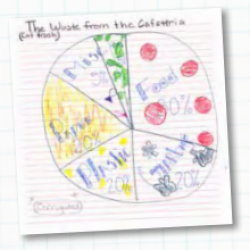Source Institutions
Source Institutions
Add to list Go to activity
Activity link broken? See if it's at the internet archive

In this activity, learners conduct a waste audit and use their findings to implement a plan for reducing trash. Learners measure trash, sort by categories (compostable, recyclable, etc.) and compile the data. Learners then share their findings and suggest ways to reduce the amount of waste.
- Under 5 minutes
- 1 to 2 hours
- $5 - $10 per group of students
- Ages 8 - 14
- Activity, Lesson/Lesson Plan
- English
Quick Guide
Materials List (per group of students)
- garbage
- safety glasses
- plastic or rubber gloves
- large plastic tarp (or equivalent)
- area to dump the waste (ideally, outside)
- pole or stick
- garbage bags
- paper and pencils
- several buckets of varying volumes (optional)
- bathroom scale (optional)
Subjects
-
Earth and Space Science
- Earth's History
-
Life Sciences
- Ecology
-
Mathematics
-
Data Analysis and Probability
- Data Analysis
- Data Collection
- Data Representation
- Geometry
-
Measurement
- Units of Measurement
- Size and Scale
-
Number and Operations
- Fractions
-
Data Analysis and Probability
-
Physical Sciences
-
Structure and Properties of Matter
- Mass and Weight
- Volume and Density
-
Structure and Properties of Matter
-
The Nature of Science
-
Science and Society
- Risks and Benefits
- Public Policy
- Ethics
-
The Scientific Process
- Conducting Investigations
- Gathering Data
- Formulating Explanations
- Communicating Results
-
Science and Society
-
The Nature of Technology
-
Technology and Society
- Impacts of Technology
- Technology and the Environment
-
Technology and Society
Informal Categories
- Nature and Environment
Audience
To use this activity, learners need to:
- see
- read
- be mobile
- touch
Learning styles supported:
- Involves teamwork and communication skills
- Uses STEM to solve real-world problems
- Involves hands-on or lab activities
Culture, ethnicity, and gender
-
Girls
- Explicity developed for this group
- Acknowledges this group's contributions to STEM
- Highlights STEM opportunities for this group
- Identifies role models or mentors in STEM fields from this group
- Uses inclusive images of people from this group
Other
Components that are part of this resource:
Includes alignment to state and/or national standards:
This resource is part of:
Access Rights:
- Free access
By:
Rights:
- All rights reserved, Twin Cities Public Television, Inc., 2010
Funding Sources:
- National Science Foundation, 0813519
- ExxonMobil
